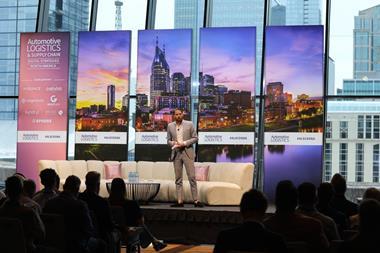 Telematics – the long range transmission of vehicle performance data – is driving a transformation in the finished vehicle supply chain, according to Jaguar Land Rover. Now the company is leading the way in the use of proprietary technology to improve the delivery of vehicles to the dealerships, according to Deborah Buswell, European distribution manager at the carmaker (left).
Telematics – the long range transmission of vehicle performance data – is driving a transformation in the finished vehicle supply chain, according to Jaguar Land Rover. Now the company is leading the way in the use of proprietary technology to improve the delivery of vehicles to the dealerships, according to Deborah Buswell, European distribution manager at the carmaker (left).
Speaking at last week’s Automotive Logistics Europe conference in Bonn, Germany, Buswell said that, as it is now mandatory that vehicles in Europe are equipped with telematics, Jaguar Land Rover is using that legal requirement to its benefit in gaining visibility of vehicles in the outbound supply chain. The company is heading off potential delays to delivery by monitoring such things as battery life and tyre pressure, as well as fuel content and odometer information. Buswell said that keeping on top of that information ensures there is no arrest in the delivery supply chain as operatives can identify the vehicle and solve any issues in the field.
JLR is using geofencing technology to get real time track and trace information and key updates on compound location (to within two parking spaces), as well as where vehicles are at port of entry and exit, and when they have been delivered to the dealer.
Buswell explained that the telematics technology is put in at the beginning of the vehicle’s life. From there on it talks to a cloud service passing on data directly to Jaguar Land Rover and onto the company’s telematics service provider, which in turn has contact with the carmaker and its dealers.
“Real time track and trace using telematics has been delivered,” said Buswell. “Real time vehicle diagnostic alerts in place, and there is development and integration of this technology.”
The eCall initiative aims to deploy a device installed in all vehicles that will automatically dial contact to an emergency centre in the event of a serious road accident, and wirelessly send airbag deployment and impact sensor information, as well as GPS coordinates to emergency services.
Asked if this information could be made available to the logistics companies tasked with moving the vehicles through the supply chain Buswell said it was data that could be shared. It is also something that more companies are likely to be embracing but Jagaur Land Rover is out in front in terms of the applications the company is putting the technology to, she said.
“Legislation demands we have eCall and telematics is the way to get that so everyone will be doing but I don’t think others are using it like this yet,” said Buswell
For Buswell this marks a move on from RFID technology, which demands additional costs in infrastructure and equipment, and a significantly greater outlay in cost compared to the obligatory use of telematics technology. It also marks a change from the old way of monitoring incar information, which often meant a lot of manual intervention by the compound operators, as well as scanning terminals and computer input. It also removes the need for EDI feeds.
As far as updating the dealerships are concerned Buswell said that telematics is enhancing the communication between them and the carmaker. “We are using the information as complementary and can tell that communications are quicker,” she said. “Feedback from dealers is in it is infancy but it can only be a positive.”
Further news and coverage from the Automotive Logistics Europe conference will be posted online. Videos of the main sessions are also available here.





































